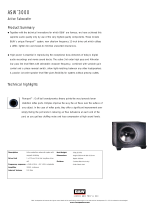
2
• Confirm that the Default Web Site and the FTP server are running under IIS before using SMARTsend.
• Confirm that the Windows Authentication Methods are properly configured in IIS before
installing SMARTsend. Integrated
Windows authentication is always required. Basic Authentication is also needed when non-Microsoft browsers are used with
SMARTsend. See “Windows Authentication Methods Configuration” on page 12..
• ASP.NET must be enabled (Windows Server 2003 only). See “Enable ASP.NET” on page 13..
• If SMARTsend is being installed on a Windows XP Professional computer, then Simple File Sharing must be disabled. Please
consult the Microsoft web site, www.microsoft.com
, for Simple File Sharing configuration instructions.
• If SMARTsend is being installed on a Windows Vista computer, configure your PC by following these instructions:
• Disable the User Account Control by opening the Control Panel and the User Accounts icon, selecting the Turn User
Account Control On or Off link and deselecting the Use User Account Control (UAC) checkbox. Select OK.
• Enable SNMP by opening the Programs and Features icon from the Control Panel, selecting the Turn Windows feature on
or off link and select the SNMP Feature checkbox. You do not need to select the WNI SNMP Provider checkbox.
• Enable the Internet Information Services by opening the Control Panel and the Programs and Features icon.
• Expand the Internet Information Services directory and then expand the FTP Publishing Service.
• Enable the FTP option under IIS. You do not need to select the FTP Management Console. Select the Web Management
Tools option.
• Expand Web Management Tools and verify that all checkboxes are selected.
• Expand WWW Services and Application Development Features.
• Select .NET Extensibility, ASP.NET, ASP, ISAPI Extensions and ISAPI Filters.
• Select the Common HTTP Features checkbox.
• Expand Common HTTP Features and verify that all checkboxes are selected.
• Expand Security and select the Basic Authentication, Request Filtering and Windows Authentication checkboxes.
• To allow a program through the Windows Firewall, open the Control Panel and the Windows Firewall icon.
• Select the Allow a Program through Windows Firewall and, from the Exceptions tab, select the File and Printer Sharing,
Secure World Wide Web Services (HTTPS), and World Wide Web Services (HTTP) checkboxes. If other programs are
selected, do not deselect those checkboxes.
• SMARTsend administrator, user, and device accounts must be configured. See “Create Administrator, User, and Device
Accounts” on page 14.
• If secure password entry is required, a security certificate must be installed (Optional). See “Obtain and Install a Security Cer-
tificate” on page 17.
• Additional configuration is required to manage the SMARTsend computer as a secure web site. See “Secure Web Site Configu-
ration” on page 3.
• Additional configuration is required on the SMARTsend computer
when using Domino.doc, SharePoint Portal Server 2001,
Novell NetWare, Remote Printers, DocuShare, and other optional destinations. See “Additional Requirements for Destinations”
on page 21.
Client and Browser Configuration Requirements
Confirm and test the following client and browser requirements prior to installing and using SMARTsend:
• Microsoft Internet Explorer version 5.5 or higher. (Internet Explorer is recommended for best performance.)
• Netscape version 7.2 or higher.
• Mozilla version 1.7 or higher.
• Mozilla FireFox version 1.0.6 or higher.
• If you are running SMARTsend on an intranet, the browser must be configured to include the SMARTsend computer in the
proxy server exceptions list. See “Modifying Proxy Server Settings” on page 23.
• Popup blockers should be disabled or reconfigured to bypass or exclude SMARTsend. Popup blocking software will prevent cer-
tain SMARTsend screens from displaying.
• When installing SMARTsend, you have the option to select the language to use for the installation (the default language is
English). During the installation, a language screen displays allowing you to select one, some, or all languages listed in which
SMARTsend Help and screens can be displayed on the browser. See “Language Settings” on page 25. for more information.
• Adobe Acrobat Reader version 4.0 or higher is required for viewing and printing PaperWare cover sheets (Professional Edition
feature) and the SMARTsend documentation.
Scanning Device Configuration
Note
An updated list of supported devices and device requirements is available from the Support & Drivers link on the Xerox web site at
www.xerox.com.








